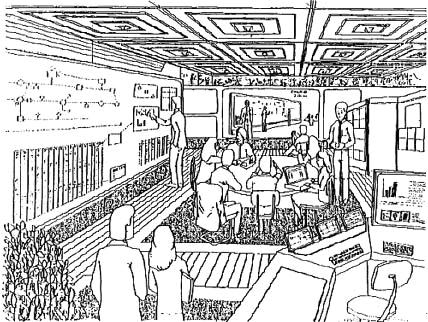1980s Concepts
In the early 1980s, I continued work on energy efficient housing. Gail and I started a large scale remodel and addition to our own house outside of Boulder but this project fell victim to high interest rates and the start up costs of MG Taylor. The house was sold, unfinished, when we were bought by ACACIA. As the decade progressed, more of our time and energy was focused on the development of Management Centers until we were almost totally captured by these challenges. The seminal concepts were developed and expressed in working environments by 1987: Anticipatory Management Center (1880) , Boulder; Mentor Management Center, Denver (1982); Ft. Belvour Fusion Center, Virginia (1982) ; Acacia Design Center, Washington D.C. (1983) ; Orlando Management Center, Orlando (1985) ; Capital Holding Design Center, Louisville (1987).
Up to 1980 most of my architectural work had been dedicated to discovering the nature of architecture and it’s practice and the specific problems associated with dwellings including, of course, working out of the home. I have always be an advocate of “mixed use” zoning. Now, the problems associated with knowledge work, technology integration and large group process became - and have remained since - my principle architectural concern.
The 10 Step Model developed in 1987and the Hilton Head KnOwhere Store
Knowledge Wall in 1996 - 10 years of Knowledge Management evolution
From my cybernetics and systems studies in the 1960s, futures work in the mid 70s and the work that Gail and did together in the late 70s, it became clear the extent that the “white collar” work place was almost totally inadequate for the needs of the emerging KnowledgeWorker. It became obvious that there needed to be a far greater integration between environment, work tools and work processes. What was required was an engine for the generation, display, reworking, storing and retrieving of information in a way that facilitates fusion with human knowledge through purposeful activity. This is what we set out to create.
Cover: 1982 Business Plan
My 1960s work had produced a system concept of computer augmentation that by the 70s I was calling “CyberConn” - Cyber from Cybernetics, Conn from taking the conn of a ship. The notion was “feedback to the one(s) steering.” By the 80s, there were primitive and expensive computer tools that could be configured to support some aspects of this program. Today, the tool kit is getting progressively more powerful and less costly. Yet, most of the THERE illustrated, above, remains beyond affordable reach and has to be accomplished by human agents instead of computer agents. Never-the-less the work algorithms remain, essentially, the same and have been worked out in the last 20 years of Mangement Center development.
The work process and technology augmentation aspects of this are covered elsewhere. The focus of this article is the architectural implications associated with our approach to work environments.
In the 1980s there were a number of challenges. There were no examples of large group interactive learning and working environments. Environments could not be easily and quickly reconfigured as need by the users. What technology that did exist was intrusive, further restricted space arrangements and got between the participants in a process. All of this added up to an environment that set the work process agenda to an overwhelming degree. These conditions largely still describe the work environment today despite talk about teams and collaboration.
When we started, we found that we had to design and build almost every element of our environments ourselves. Today, we have one of the most comprehensive suites of WorkFurniture™ produced by any manufacture in the world. And, we have almost the only designs that were driven by an intimate understanding of the work-process requirements. Putting wheels on furniture derived from the old work-habits will not get it done.
Besides the component aspects of the environments there were other issues we had to deal with: lighting, enough open, unobstructed space for large groups, acoustics, appropriate ceiling heights, plug and play technology, the creation of adequate spacial and psychological variety, were among them.
In total, the entire “office” environment had to be preconceived and new working-labs created so that a new evolution could be started. For twenty years now, we have been facilitating teams of all sizes through a variety of challenges in environments that we have created. This has created one of the largest bodies-of-knowledge in existence regarding how the integration of environment, tools and processes impacts human creativity.
posted March 2, 1999
revised November 3, 1999
1999113.165358.mt
note: this document is about 95% finished
